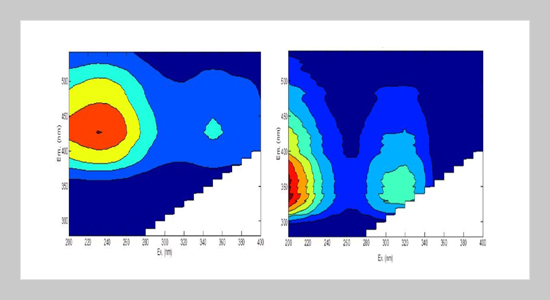REFERENCES
- [1] Sillanpää, M., M. C. Ncibi, A. Matilainen and M. Vepsäläinen. (2018) Removal of natural organic matter in drinking water treatment by coagulation: A comprehensive review. Chemosphere 190, 54-71.
- [2] Lai, C. H., Y. C. Chou and H. H. Yeh. (2015) Assessing the interaction effects of coagulation pretreatment and membrane material on UF fouling control using HPSEC combined with peak-fitting. Journal of Membrane Science 474, 207-214.
- [3] Hidayah, E. N, Y.C. Chou and H. H. Yeh. (2016) Using HPSEC to identify NOM fraction removal and the correlation with disinfection by-product precursors. Water Science and Technology 16(2), 305-313.
- [4] Murphy, K. R., C. A. Stedmon, T .D. Waite and G. M. Ruiz. (2008) Distinguishing between terrestrial and autochthonous organic matter sources in marine environments using fluorescence spectroscopy. Marine Chemistry 108(1-2), 40-58.
- [5] Coble, P.G. (2007) Marine chemical biogeochemistry: the chemistry of ocean color. Chemical Reviews, 107, 402-418.
- [6] Murphy, K. R., C. A. Stedmon, D. Graeber and R. Bro. (2013) Fluorescence spectroscopy and multi-way techniques PARAFAC. Analytical Methods 5(23), 6557-6566.
- [7] Hidayah, E.N., Y.C. Chou and H. H. Yeh. (2017) Comparison between HPSEC-OCD and F-EEMs for assessing DBPs formation in water. Journal of Environmental Science and Health, Part A 52 (4), 391-402.
- [8] Tran, N. H., H. H. Ngo, T. Urase and K. Y. H. Gin. (2015) A critical review on characterization strategies of organic matter for wastewater and water treatment processes. Bioresource Technology 193, 523-533
- [9] Zhu, G., J. Yin, P. Zhang, X. Wang, G. Fan, B. Hua, B. Ren, H. Zheng and B. Deng. (2014) DOM removal by flocculation process: fluorescence excitation–emission matrix spectroscopy (EEMs) characterization. Desalination 346, 38-45.
- [10] Pifer, A.D. and Fairey, J.L. (2012) Improving on SUVA 254 using fluorescence-PARAFAC analysis and asymmetric flow-field flow fractionation for assessing disinfection byproduct formation and control. Water Research, 46 (9), 2927–2936.
- [11] Edzwald, J. K and J. E. Tobiason. (2011) Chemical principles, source water composition, and watershed protection. In: Edzwald, J. K., editor. Water quality and treatment: a handbook on drinking water. AWWA McGraw-Hill: New York.
- [12] Chow, C. W. K., J. van Leeuwen, R. Fabris and M. Drikas. (2009) Optimised coagulation using aluminium sulfate for the removal of dissolved organic carbon. Desalination 245(1-3), 120–134
- [13] Shon, H. K., S. Vigneswaran and S. A. Snyder. (2012) Effluent organic matter (EfOM) in wastewater: constituents, effect, and treatment. Critical Reviews in Environmental Science and Technology 36(4), 327-374.
- [14] Shao, S., H. Liang, F. Qu, H. Yu, K. Li and G. Li. (2014) Fluorescent natural organic matter fractions responsible for ultrafiltration membrane fouling: identification by adsorption pretreatment coupled with parallel factor analysis of excitation–emission matrices. Journal of Membrane Science 464, 33–42.
- [15] Yu, H., H. Liang, F. Qu, Z. S. Han, S. Shao, H. Chang and G. Li. (2015) Impact of dataset diversity on accuracy and sensitivity of parallel factor analysis model of dissolved organic matter fluorescence excitation-emission matrix. Scientific Reports 5, 1–10.
- [16] Graeber, D., J. Gelbrecht, M. T. Ousch, C. Anlanger and D. von Schiller. (2012). Agriculture has changed the amount and composition of dissolved organic matter in Central European headwater streams. Science of the Total Environment 438, 435-446.
- [17] Xie, P., Y. Chen, J. Ma, X. Zhang, J. Zou, J. and Z. Wang Z. (2016). A mini review of peroxidation to improve coagulation. Chemosphere, 155, 550-563.
- [18] Ignatev, A and T. Tuhkanen. (2019). Step-by-step analysis of drinking water treatment trains using size-exclusion chromatography to fingerprint and track protein-like and humic/fulvic-like fractions of dissolved organic matter. Environmental Science: Water research and Technology, 5, 1568-1581.
- [19] Hidayah, E. N and O. H. Cahyonugroho. (2019). Tracking of dissolved effluent organic matter (dEfOM) in wastewater treatment plant by using fluorescence method. IOP Conference Series: Earth and Environmental Science 245 (1).
[20] Li , W.T., M. Majewsky, G. Abbt-Braun, H. Horn, J. Jin, Q. Li, Q. Zhou and A.M. Li. (2016) Application of portable online LED UV Fluorescence sensor to predict the degradation of dissolved organic matter and trace organic contaminants during ozonation, Water Research, 11, 262-271.
















